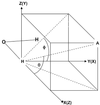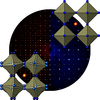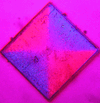issue contents
June 2015 issue

Cover illustration: A building at Melbourne's Federation Square featuring a pinwheel tiling façade. See Fig. 16 of Grimm [(2015), Acta Cryst. B71, 258–274].
scientific commentaries
Free 

High pressure has become an indispensable research tool in the quest for novel functional materials. High-pressure crystallographic studies on non-porous framework materials based on coordination compounds are markedly on the rise, enabling the unravelling of structural phenomena and taking us a step closer to the derivation of structure–property relationships.
Free 

Once a contradiction in terms, aperiodic crystals show instead that `long-range order' has never been defined. Whatever it means, decades of intense research have shown it to be more complex and surprising than anyone suspected.
feature articles
Download citation


Download citation


Free 

High-pressure synchrotron powder diffraction studies of the magnetic molecular framework cobalt(II) dicyanamide, Co(dca)2, revealed a reversible orthorhombic to monoclinic transformation at 1.1 GPa and negative linear compressibility over the measured pressure range up to 4.2 GPa.
Free 

The notion of order in spatial structures is discussed in the context of mathematical diffraction theory, with particular emphasis on aperiodic crystals and non-crystalline structures.
research papers
Statistical analysis is made of the influence of the disposition of near neighbours on the water structure in hydrated metal complexes.
Download citation


Download citation


The molybdenum zinc thiourea complex crystals are observed in molecular orientations resulting in a facile charge transfer leading to non-linearity.
CCDC reference: 1055810
n-Nonadecane–urea is an aperiodic molecular composite. Neutron Laue and X-ray diffraction studies reveal there is a supplementary phase transition within the crystallographic superspaces.
Download citation


Download citation


Single-crystal X-ray diffraction experiments were performed for the whole series of inverse perovskites, M3TtO (M = Ca, Sr, Ba, Eu; Tt = tetrel element: Si, Ge, Sn, Pb) in the temperature range 500–50 K. Depending on M and Tt, temperature-driven phase transitions were observed; they all take place together with multiple twinning.
Download citation


Download citation


Open  access
access
 access
accessSingle-crystal neutron diffraction, ab initio calculations and Raman spectroscopy are applied to study the structure and hydrogen bonding of magnesium selenate enneahydrate, a recently discovered new hydration state in M2+XO4 hydrates and a unique example of a material with a cation: (oxy)anion:water ratio of 1:1:9, giving novel insights into the polymerization of water in highly hydrated materials.
Download citation


Download citation


Crystals of K2[SiF6] were grown in agar gel. They have a cubic structure as refined from X-ray diffraction data, however, they exhibit birefringence in six regular domains.
CCDC reference: 1059988
Download citation


Download citation


Crystal structure and atomic net charges of LiNaSO4 are explored by X-ray diffraction and refined by the program MOLLY under integer ionic constraints. A relationship between the optical refractive indices and the second electric moment, derived from the model, is manifested.
CCDC reference: 1057951
Group theoretical methods are used to explore the possibilities for tilting of the corner-connected octahedra in hexagonal and tetragonal tungsten bronzes. Connection is made with the structures reported for these materials.
Download citation


Download citation


The structure of two new nanocrystalline phases, K5Al(W3O11)2 and NaAl(WO4)2, was determined by automated electron diffraction tomography. Structure analysis was complicated by pseudo-symmetry and the presence of additional phases.
Download citation


Download citation


The first refinement of modulated mullite in the superspace approach is presented disclosing a modulated average structure of basically disordered mullite. It is discussed as to why mullite does not form a perfectly long-range ordered structure, although simple superstructures can easily be set up which are compatible with the chemical composition.
B-IncStrDB reference: 11262E9iecH
CCDC reference: 1060127
A structural analysis from the Cambridge Structural Database of the transition metal–dinitrogen fragment species was performed. The analysis of the bound precursor fragment can be useful to provide information about its fixation and activation.


 journal menu
journal menu






































